Blog
What To Do in Rio de Janeiro: 70+ Tourist Attractions
- Thursday January 27th, 2022
- Posted by: Amanda Ennes
- Category: Rio de Janeiro
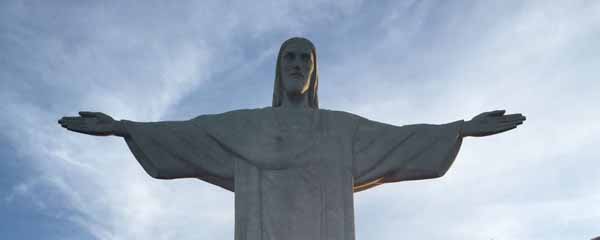
If you are looking for what to do in Rio de Janeiro, Caminhos lists 70+ activities and attractions in the Wonderful City.
Table of Contents
ToggleChrist the Redeemer Statue
The Christ the Redeemer Statue (Cristo Redentor) is 30 meters in height, with arms stretching 28 meters. It is the most famous landmark in Brazil. Located at the peak of the Corcovado Mountain in the Tijuca National Park, and overlooking the city of Rio de Janeiro, it is one of the New Seven Wonders of the World.
You can get there by taking the train in Cosme Velho or a van in Copacabana, Largo do Machado or Paineiras. There is also an option to hike to Corcovado from Parque Lage.
Sugarloaf Mountain
Along with Christ the Redeemer Statue, Sugarloaf Mountain (Pão de Açúcar) is also one of the most famous landmarks in Rio de Janeiro. Its peak is almost 400 meters above sea level and you can get there by taking a cable car.
From the top of the mountain, you have a 360º view of Rio de Janeiro, overlooking Copacabana, Ipanema, Botafogo, the Santos-Dumont airport, the Guanabara Bay, the city of Niterói, and more. There is a coffee shop, a snack bar, a few restaurants, souvenir stands, and lounge areas over there.
Lagoa Rodrigo de Freitas
Lagoa Rodrigo de Freitas is a lagoon in Rio de Janeiro that serves numerous entertainment purposes. There is a cycle path of 8.200 meters in length for people to ride their bikes or walk, green areas for picnics, paddleboats for renting, bars and restaurants, a dog park, and more. Moreover, there are also several sports grounds to use, such as football and baseball fields, basketball courts, and a skating rink.
Read more: 16 Free Things To Do In Rio De Janeiro
City Center
What to see/visit:
- Royal Portuguese Cabinet of Reading
- Municipal Theater
- Praça XV
- Metropolitan Cathedral of Saint Sebastian
- Arco de Teles
- Paço Imperial
- Mosteiro de São Bento
- Igreja de Nossa Senhora da Candelária
- Palácio Tiradentes
- Rua do Ouvidor
If you have a bit of money to spare, it is totally worth paying for a guided tour to the City Center of Rio de Janeiro, as this part of the city has much history from the colonial and imperial times of Brazil.
Ilha Fiscal
Ilha Fiscal (Fiscal Island) was the venue for an event known as “The Last Ball of the Empire”, in 1889. Today, the island houses a museum maintained by the Brazilian Navy. The tour to the island is carried out with a schooner and lasts about 10 minutes. Arriving at the castle in the middle of the island, specialized tour guides take the visiting groups on tours, showing them the halls, the turret, and the permanent exhibitions they have there. The entire visit lasts about 2 hours.
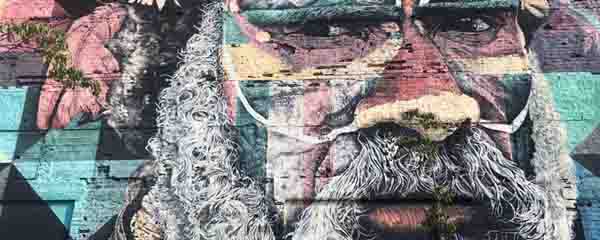
Olympic Boulevard
The Olympic Boulevard was the cultural epicenter of the Rio 2016 Olympics. Furthermore, it is home to the largest street art mural in the world. Painted by Eduardo Kobra, the Ethnicities Mural is 5,742 square meters and portrays the union among the peoples from the five continents of the world.
The Olympic Boulevard is also home to the Museum of Tomorrow, the Rio Star Ferris wheel, and AquaRio Aquarium. It also hosts several street fairs, live concerts, and events throughout the years.
SAARA and Uruguaiana
Rio’s city center is a great option for shopping. The Saara market covers a few blocks in Centro and is an open shopping complex where you can buy cheap products — clothes, toys, costumes, party items, and much more. More than 120 stores are spread into these four main streets: Rua da Alfândega, Rua Uruguaiana, Rua Buenos Aires, and Rua Senhora dos Passos.
Uruguaiana is another shopping complex in Centro. It is like a huge warehouse with different shopping stands.
Confeitaria Colombo
Confeitaria Colombo is a traditional bakery in Centro. Portuguese immigrants founded this coffeehouse back in 1894 inspired by the European cafes, a representation of Rio de Janeiro’s belle époque. Between 1912 and 1918, the shop was renovated with an Art Nouveau flair, with large crystal mirrors and carved wooden furniture.
Furthermore, the bakery offers a nice variety of breakfast and afternoon tea buffets and a vast menu to choose from.
Sambódromo
The Sambadrome Marquês de Sapucaí is the place where samba schools parade competitively each year during Carnival. It consists of a 700 meters street with bleachers and special cabins for spectators. There are guided tours that explain the history of the sambadrome, samba, and how carnival works.
National Library
The National Library of Brazil is the oldest Brazilian cultural institution — it is over 200 years old — and has a heritage of approximately 9 million items. Besides books, manuscripts, cartography, newspapers, and such, the library also hosts an office for copyright registration.
Santa Teresa
Santa Teresa is considered the most cultural neighborhood in Rio de Janeiro. The artists love Santa Teresa and there are many art studios and galleries there. The neighborhood is known as a meeting point for intellectuals, academics, artists, and politicians. Because of its bohemian vibe, Santa Teresa has also great hippie bars and restaurants. The famous Selarón Stairs connect Santa Teresa and Lapa, being both a touristic sight in Rio and a passageway for residents. Parque das Ruínas is also located in Santa Teresa. It is a park with an art gallery built around the ruins of a mansion. It also serves as a venue for concerts and alternative parties.
Parque das Ruínas
Parque das Ruínas is a cultural center that features an auditorium, exhibition hall, and a cafeteria. It is used for concerts, happy hour gatherings, and readings. There is a 360-degree observation deck on top of the old house with an admirable view of Rio de Janeiro. In outdoor areas, there are special programs for children on the weekends. The park runs from Tuesday to Sunday from 8 am to 8 pm. Admission is free.
Feira de São Cristóvão
The Centro Luiz Gonzaga de Tradições Nordestinas, also called the São Cristóvão Fair (Feira de São Cristóvão), is a huge place that promotes the Brazilian northeast’s culture in Rio de Janeiro. At the fair, there are restaurants with traditional northeastern food, karaoke bars, a stage for live concerts, dance presentations, and more. Also at the fair, there are lots of different stores selling traditional northeastern products, such as fruits, nuts, musical instruments, special spices, hammocks, clothes, leather shoes, and jewelry.
Paquetá
The Paquetá Island is a bucolic auto-free zone in Rio de Janeiro and a lovely tourist spot to spend the day. People like to rent a bike to ride through the island and enjoy the afternoon. Moreover, there are restaurants, picnic areas, and beautiful places to take pictures.
AquaRio
AquaRio is the largest aquarium in South America, with a building of over 26,000 m² and 4,5 million liters of water. It also has over 5,000 animals from 350 species.
One of the largest attractions of AquaRio is the main tank, featuring an underwater tunnel that passes through the aquarium. It is the perfect experience for you to observe fishes, stingrays, and sharks. AquaRio also has a special tank where kids can interact with animals, touching and playing with some of them.
Rio Star
Open to the public in December 2019, the largest Ferris wheel in Latin America is located in the docks area of Rio de Janeiro. Measuring 88 meters in height, Rio Star has 54 cabins with a capacity for eight passengers each. The full ride takes from 15 to 18 minutes. Rio Star is among the 30 tallest Ferris wheels in the world.
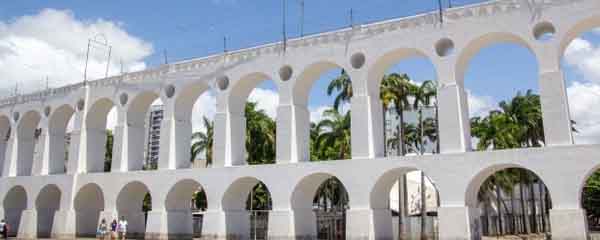
Lapa
Lapa is a neighborhood in the Central Zone of Rio de Janeiro. It is known for its architecture, starting with the Aqueduto da Carioca (Arcos da Lapa), its main reference and landmark.
Moreover, Lapa is known as the nest of carioca’s bohemian life. There are dozens of bars, restaurants, nightclubs, and theme pubs scattered through its 13 streets. And if you would rather hang out on the sidewalks, drinking your own beer and enjoying the nearby music, you can do just that.
It does not matter what your interests are — if you want to listen to good music, dance, or hang out with friends. Nightlife in Lapa is definitely something to be experienced in Rio de Janeiro!
Escadaria Selarón
Escadaria Selarón is one of the most famous landmarks in Rio de Janeiro. This staircase is located between Joaquim Silva Street in Lapa and Pinto Martins Street, in the Santa Teresa neighborhood. It is just a 5-minute walk away from Arcos da Lapa. The staircase, decorated with numerous colored tiles, is the work of Chilean artist Jorge Selarón. It is a well-known tourist spot in Rio, visited by people who like to take pictures.
Museums
-
Museum of Tomorrow
The Museum of Tomorrow is located at Praça Mauá in Centro. It is a science museum that mixes the human race, the planet Earth and the future through digital experiments and experiences. The museum also connects science and technology with the importance of sustainability. Sustainability itself is one of the guidelines for the Museum of Tomorrow. The museum uses the water from Guanabara Bay in the air conditioning system and captures solar energy through photovoltaic panels installed on the roof of the building. Everyone loves to visit Museu do Amanhã — kids and adults — as it is one of the greatest cultural tours in Rio de Janeiro.
-
National Museum of Fine Arts
The National Museum of Fine Arts was inaugurated in 1938 and it is the most important museum for Brazilian art. Nowadays, the museum has a collection of 20 thousand pieces. Among the permanent exhibitions are works by Pedro Américo, Zeferino da Costa, Jean-Baptiste Debret, Candido Portinari, Di Cavalcanti and Tarsila do Amaral.
-
National Historical Museum
The National Historical Museum is the most important museum of Brazilian history. It has a collection of over 300,000 items, including objects, documents, and books. Moreover, it offers galleries for long-term and temporary exhibitions, in addition to a library specializing in the history of Brazil, history of art, museology, and fashion, with important paintings, illustrations, and photography.
-
Espaço Cultural da Marinha
The Marine Cultural Space is a cultural center located in the city center of Rio de Janeiro. The place houses an important part of the collection of the Brazilian Navy. There is a submarine for you to visit, as well as a navy ship and helicopter.
-
Museu Seleção Brasileira – CBF
This museum is very interactive and modern. A guided tour will escort you through some rooms where you will be able to touch, listen, watch, and read all about football and the national team. You will travel through time through short films and photos telling the story of football, the first competitions, and the most important players in history. There are also interactive boards, games, and collections for you to check.
And if that is not impressive already, you will get to see all of the five FIFA World Cup trophies Brazil was won so far. It is definitely a must-go for all football lovers out there.
-
Centro Cultural Banco do Brasil
CCBB is a museum that houses theatres, cinemas, and multiple art galleries.
-
Museu de Arte do Rio
The Museu de Arte do Rio houses exhibition halls, as well as a school that hosts academic programs on art, culture, and education.
Read more: The Best Cultural Tours in Rio de Janeiro
Maracanã Stadium
A guided tour to the Macaranã stadium will take you behind the scenes of the most famous stadium in the world. There is a permanent exhibition with outstanding pieces of the history of football in Brazil. Among the things you will be able to see, there is a uniform worn by Garrincha in the 1962 World Cup and Zico’s memorabilia.
A bilingual guide will also show you the dressing, warming, press rooms, and the football field. The tours have an average duration of 40 minutes.
Street Fairs
-
Feira do Lavradio
Feira do Lavradio (The Lavradio’s Fair) occurs every first Saturday of the month, beginning at 10 am on Lavradio Street, Centro. About 400 exhibitors sell decorative objects, clothes, jewelry, and lots of antiques. Other than the fair, there are many stores and restaurants on the same street – so you can make that a day-long trip. The exhibitors also promote concerts, photography exhibitions, and dance presentations at the fair. The event is free, but we are sure you will want to go shopping for a little bit…
-
Feira Hippie
The Ipanema Hippie Fair is an outdoor arts and crafts gallery.
-
Farmers’ Markets
In Brazil, it is very common for people to buy fruits and vegetables at street markets. They take place in many parts of the city — each one of them has its exact day and place. The best thing is to visit the street markets very early in the morning to choose the freshest fruits. However, at the end of the day, it is common to get better prices for the remaining products. They usually run from 7 am until 1 pm.
A few addresses:
Mondays: Rua Gustavo Sampaio – Leme
Tuesdays: Praça General Osório – Ipanema
Wednesdays: Praça Edmundo Bittencourt – Copacabana
Thursdays: Praça Nossa Senhora Auxiliadora – Leblon
Fridays: Praça Nossa Senhora da Paz – Ipanema
Saturdays: Praça Nelson Mandela – Botafogo
Sundays: Praça Tenente Gil Guilherme – Urca
Tijuca National Forest
The Tijuca National Park (Parque Nacional da Tijuca) protects the biggest man-made urban forest in the world, with a 3.953ha extension of Rainforest. It receives more than three million visitors a year, including Brazilians and foreigners of all ages.
Divided into three visiting sectors, the park offers activities options for everyone: from picnic and barbecue areas to hang-gliding, rock climbing, hiking, and others. There is also a waterfall and a few creeks where you can refresh yourself.
Vista Chinesa
Vista Chinesa is a gazebo that provides a great view of Rio de Janeiro from the inside of the Tijuca National Forest. It offers a scenic view of the South Zone of Rio de Janeiro, a lovely place to take amazing pictures to take home with you.
Ilha da Gigóia
Ilha da Gigóia is a small village right in the middle of the busy neighborhood of Barra da Tijuca. The only way to get there is by taking a boat near the Jardim Oceânico subway station. Furthermore, there are a lot of cool bars, restaurants, bed and breakfasts, and beach clubs so you can enjoy a nice day far from the busier tourist attractions.
Sítio Roberto Burle Marx
Roberto Burle Marx was a Brazilian landscape architect, famous for designing parks and gardens. What is now called Sítio Burle Marx was his home from 1973 until 1994, the year of his death. Today, the area works as a study center for landscaping, botanical studies, and nature conservation.
Currently, the park is home to thirty-five hundred species of plants, especially tropical plants from Brazil. It is also known as one of the most important collections of living plants in the world.
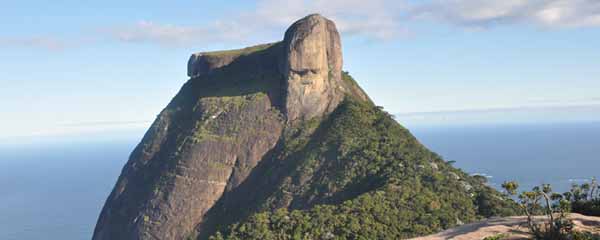
Hikes
Read our blog post Top 7 Hikes In Rio De Janeiro: Fun And Adventure! and learn everything about the best hike spots in Rio de Janeiro.
- Morro da Urca
- Pedra Bonita
- Pedra da Gávea
- Morro Dois Irmãos
- Pedra do Telégrafo
- Pico da Tijuca
- Prque da Catacumba
- Pedra do Leme
Parque Lage
Located in Jardim Botânico, Parque Henrique Lage is a 52-hectare park founded in 1811 and the right choice for a place to spend your day. Within the area, there are activities for all ages, including a children’s playground, hiking paths – one of them leads to the Christ the Redeemer statue – a fountain, an aquarium, a few picnic and rest areas, and a parking lot. Inside the park, there is also the Escola de Artes Visuais do Parque Lage (School of Visual Arts of Parque Lage), which has occupied the main Palace of the park since 1975 and exhibits students’ art to the public.
Botanical Garden
The Botanical Garden of Rio de Janeiro is an ecological sanctuary. It houses rare species of plants of Brazilian flora and it is one of the best places for birdwatching. King John VI of Portugal founded The Botanical Garden in 1808. Today, it has around 6,500 species of flora distributed throughout an area of 54 hectares. Besides that, capuchin monkeys and tufted-eared marmosets are also frequently seen in the Botanical Gardens.
Read more: Fauna and Flora of Rio de Janeiro: Explore Rio’s Nature
BioParque do Rio – Rio Zoo
This is one of the oldest city zoos in Brazil. It is a biological park, focusig on environmental education, research, and conservation.
Forte Copacabana
Visiting the Copacabana Fort is not only a good option because of the breathtaking view of the ocean, but it is also a great choice for those who like museums and history. In the Army Historical Museum (Museu Histórico do Exército) there is a permanent exhibition of documents and old objects that tells the Brazilian Army’s history. There are also other rooms where you can see collections of original objects from the colonization era.
In the outside area, there are stores and coffee shops. There is also a branch of the Confeitaria Colombo – a traditional pâtisserie from downtown Rio – where you can find a wide variety of sweets and snacks. The entrance is free every Tuesday.
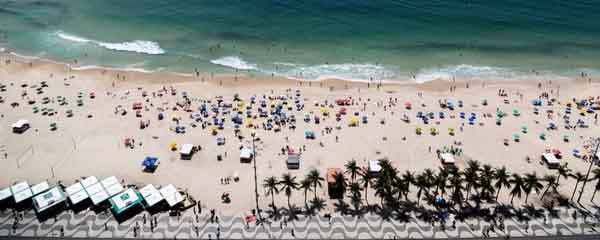
Copacabana
Copacabana is the most famous neighborhood in Rio de Janeiro and one of the most famous places in Brazil. This is a busy neighborhood: easy access to transportation, great bars and restaurants, unlimited options for shops and grocery stores, and countless hotels. Not to mention, it is home to the world-famous Copacabana Beach and its promenade.
The Copacabana Beach promenade is 4km long, from Leme to Forte de Copacabana, and has a wavy design to mimic the ocean’s flow.
Ipanema
Ipanema is one of the most traditional neighborhoods of Rio de Janeiro’s Zona Sul (south region). Besides being one of the most famous neighborhoods of Rio, it is also between other famous and interesting neighborhoods – Leblon, Copacabana, and Lagoa.
This neighborhood is well known throughout the world, if not for its beach, for the “The Girl from Ipanema” song.
Beaches
Read our blog post Rio De Janeiro Beaches: Discover The Best Beach For You and learn more about the best beaches in Rio de Janeiro.
- Copacabana Beach
- Ipanema Beach
- Leblon Beach
- Arpoador
- Praia Vermelha
- Joatinga
- Reserva
- Praia da Barra
- Prainha
- Praia do Secreto
- Grumari
Mureta da Urca
If you are into offbeat places, where locals hang out, with an informal and casual vibe, you should spend an evening at Mureta da Urca. However, do not think this is a bar, restaurant, or anything like that. Mureta da Urca is nothing more than a small stone wall that stands beside the Guanabara Bay. This is a friendly place where Cariocas go to watch the sunset and have a few cold drinks with their friends. Just buy your drinks in a nearby bar and sit down at the Mureta for a pleasant afternoon/evening.
Lesser-known tourist sights in Rio de Janeiro
If you want to visit someplace not a lot of tourists know about in Rio de Janeiro, check this blog post for the lesser-known tourist sights in Rio de Janeiro.
Learn Portuguese in Rio de Janeiro
Caminhos Language Centre is the largest and most exciting Portuguese school in Rio de Janeiro, Brazil. We have an excellent infrastructure, over 15 experienced Brazilian teachers, and a friendly multilingual support staff. We are the only school in Brazil able to offer Portuguese group courses throughout the year on 10 levels (beginner to high advanced and Spanish/Italian speakers).
At Caminhos, we offer group classes and private lessons, accommodation options, and student visa support. Moreover, every day we offer a range of free after-class activities for our students.


 Deutsch
Deutsch Français
Français Português
Português Español
Español
